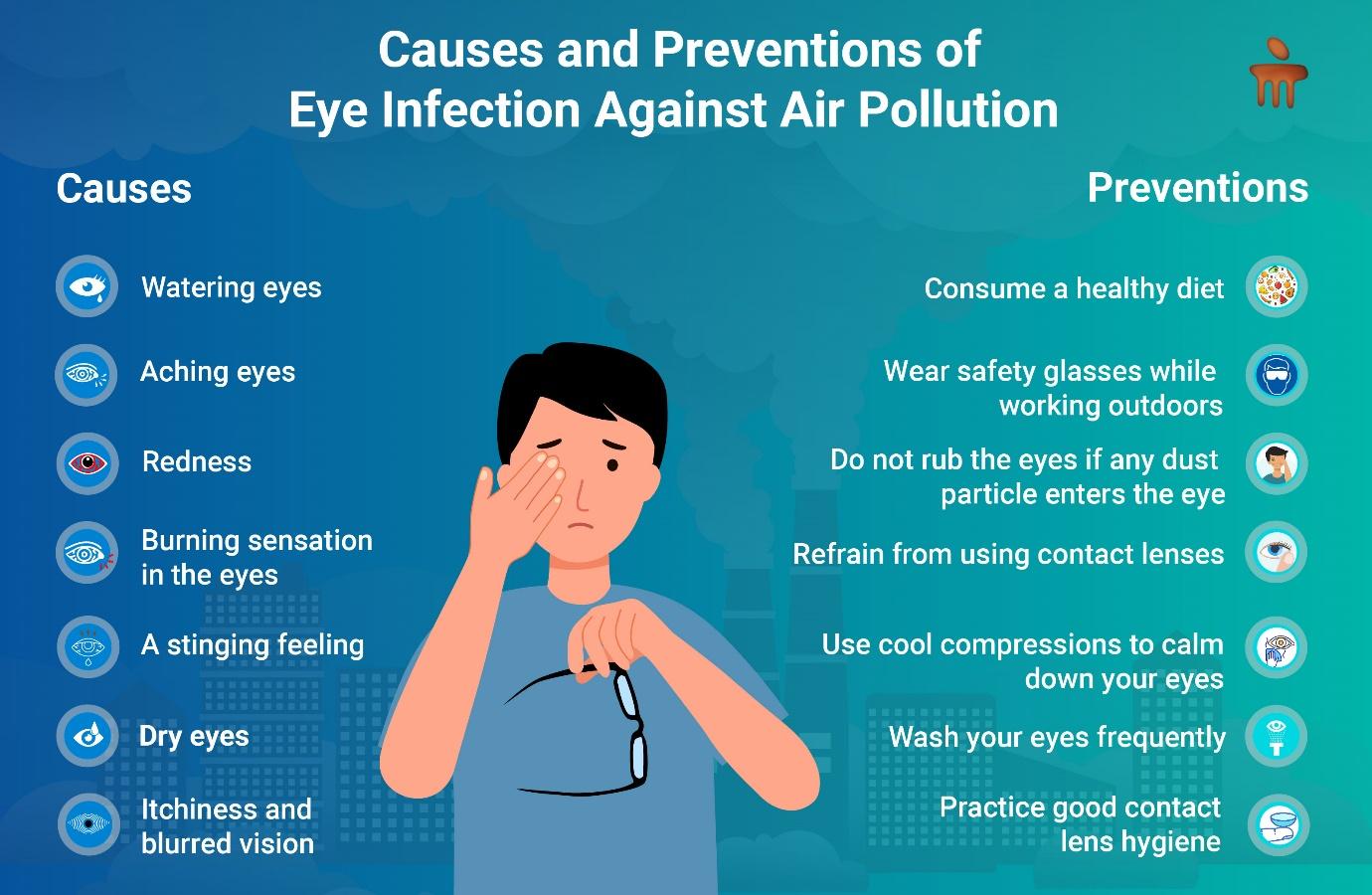
Air pollution is an unavoidable hazard that distorts a good vision of an individual. It is one of the ten dangers that distort one's vision and respiratory system. The inhalation of the particular matter is reduced significantly while wearing masks, but our eyes are still exposed to the polluted air. Hence people report eye discomfort 3-4 times a day. The presence of sulphur dioxide, nitrogen oxide and nitric acid can make the eye tear film more acidic, creating itchiness, watery eyes, and a burning and itchy sensation in the eyes. These can create serious problems if they are not treated on time.
With air quality reaching the poorest levels, we are breathing in dangerous levels of toxins like carbon dioxides and dust particles. Eye infections are very much popular amongst all age groups irrespective of age or gender because of particularly sensitive air quality making them vulnerable to allergies and irritation brought by air pollution.
Consult the best eye hospital in Bangalore if you require treatment for an eye infection.
Effects of Air Pollution
Numerous aspects of air pollution can impact eye health, including air quality, sun exposure and even humidity. Air pollution is not only found outdoors, the air that we inhale indoors is also one of the forms of air pollution.
A few other forms of air pollution are listed below:
-
Dry air and wind
-
Smog
-
Dust (both indoor and outdoor)
-
Aerosol sprays, such as hairspray and household cleaners.
-
Humidity and other weather factors
Certain areas may produce more irritants than others. For example, air can be saltier near beaches, and there may be more fumes in areas with volcanic activity. Smoke damage to the eyes can occur more often in industrial areas and regions where wildfires are common. Here are a few other effects of air pollution:
-
Chronic Dry Eye May Result from Dry Conditions
Dry eyes directly result from environmental factors such as wind, dust, and aridity and can eventually develop into a chronic condition. Living in a dry atmosphere or frequently being exposed to one exacerbates the issue and makes your eyes more sensitive to irritants caused by pollution. Dry surroundings and airborne irritants like dust and pollen can impact tear film and result in issues like Meibomian gland dysfunction, an inflammation of the little glands that generate tears in your eyelids.
-
Toxins Can Restrict Blood Flow to the Eyes
According to studies, a high level of airborne pollutants might obstruct the blood flow in the eye's blood vessels. Eye stroke, retinal vein occlusion, glaucoma, and other conditions can result from reduced or stopped normal blood flow in the eyes.
-
Cooking Fire Smoke could be a Factor in Trachoma Development
Increased pollution exposure can exacerbate eye infections and other chronic problems. According to research, a bacterial illness known as trachoma might cause more scarring if a person is regularly exposed to charcoal or wood cooking fires. Since trachoma is the primary infectious cause of blindness worldwide, this could have long-term consequences.

Common Eye Problems From Air Pollution
The most common eye problems brought by air pollution are:
-
Watering eyes
-
Aching eyes
-
Redness
-
Burning sensation in the eyes.
-
A stinging feeling
-
Dry eyes
-
Itchiness and blurred vision.
Ways to protect the eyes from the adverse effects of air pollution
-
Consume a healthy diet
-
Wear safety glasses while working outdoors.
-
If dust particles mistakenly enter the eyes, then it is advisable not to rub them.
-
Retain from using contact lenses if the eyes are not comfortable with the lenses
-
Use cool compressions to calm down your eyes
-
Try to wash your eyes frequently if your eyes are not comfortable with the hot weather accompanied by the dust storms
-
Practice good contact lens hygiene.
Long-term air pollution leads to the erosion of the eye and eye health in general. The air pollution that we are experiencing today is slowly and steadily responsible for the overall health of the eye, and if we are keeping our eyes open for such a situation, then it might bring drastic consequences the way forward.
Recommended Read: Bye Bye Dark Circles: 7 Easy Tips For Brighter and Fresher Looking Eyes
FAQs
-
List down the Main Effects of Air Pollution on One's Eyes.
The effects of air pollution vary from one individual to another, but the common factor remains consistent in having eye diseases like blurry vision or conjunctivitis.
-
How to Protect Your Eyes from Air Pollution?
The adverse effects of air pollution on the eyes can be avoided by following the activities listed below.
Here are a few of them:
-
People who live in more polluted areas have an increased risk of eye problems.
-
Wear UV-protective sunglasses and a wide-brimmed hat for protection against UV rays.
-
Avoid jogging in areas with heavy traffic (there is more vehicle-related pollution).
-
Wear protective goggles when doing any outdoor activity.
-
Avoid rubbing or scratching your eyes.
-
Stay indoors, if possible, when the air quality is low.
-
Keep the car windows closed when driving to avoid eye irritation from wind and debris.
-
Remember to wash your hands frequently.
-
Practice good contact lens hygiene.
-
List down the main types of air pollution that affect eye health.
Numerous aspects of air pollution can impact eye health, including air quality, sun exposure and even humidity. To name a few:
-
Air pollution (indoors and outdoors).
-
Dry air and wind.
-
Smog
-
Dust (both indoor and outdoor).
-
Aerosol sprays, such as hairspray and household cleaners.
-
Humidity and other weather factors.
Certain areas may produce more irritants than others. For example, air can be saltier near beaches, and there may be more fumes in areas with volcanic activity. Smoke damage to the eyes can occur more often in industrial areas and regions where wildfires are common. Desert-like environments are dryer than other climates, which can cause additional irritation.
-
What are the short and long-term effects of air pollution on the eyes?
Air pollution affects the eyes in several ways, both in the short and long term. Sometimes, short-term effects can lead to long-term conditions, so it's important to treat issues immediately and protect your eyes from further harm.
Short-term effects:
-
Worsened eye allergies and a higher risk of allergic conjunctivitis.
-
Dry eyes — especially for contact lens wearers.
-
Itching, burning and other irritation.
-
Eye redness.
-
Blurred vision.
-
Watery eyes.
Long-term effects:
-
Dry eye syndrome.
-
Meibomian gland dysfunction.
-
Blepharitis.
-
Glaucoma.
-
Eye stroke or retinal vein occlusion.
-
Cataracts.
-
How to repair damage to your eyes from air pollution?
Some steps can be executed to improve the condition if there has already been eye damage from air pollution. Depending on the issue's seriousness, various home cures can be considered. The natural treatments include:
-
Use a cool compress to relieve eye inflammation.
-
Use lubricating eye drops for dry eyes.
-
Use a humidifier to provide moisture to the air and alleviate the symptoms of dry eyes.
-
To lessen indoor air pollution, think about utilising an air purifier.
Consult an eye specialist in Bangalore if you require treatment for an eye infection caused by air pollution.
Conclusion
Find the ideal strategies with the advice of your eye doctor, especially if home remedies are ineffective. Different demands may apply depending on the environment, medical history, and intensity of the symptoms. Additionally, it is advisable to schedule a full eye check-up with the doctor once a year. The doctor can use this to detect any changes in the patient's vision, including any modifications that the environment's air quality may have caused.






















 7 Min Read
7 Min Read










